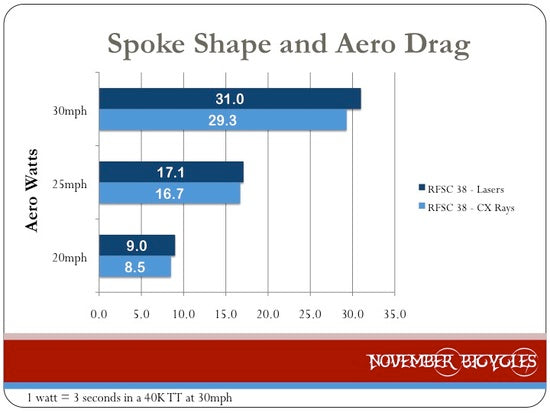One of the things we've learned is that offering choices invites questions. One we get all the time is the difference between Sapim Lasers and CX-Rays, which we offer in all our wheels. Or rather, the question really is whether CX-Rays are worth the extra money.
The answer we've always provided is that the spokes are the same weight but CX-Rays are purported to have some aerodynamic advantage. If you're looking for "every last watt of speed," they're the way to go. But we have never seen anything that quantifies the difference between the two in a wheelset. So we decided test Lasers against CX-Rays in the tunnel to give a more informed and specific response than "every last watt of speed."
It turns out, however, that we've been exactly right all along.
We sent two RFSC 38 (38mm) wheels to the wind tunnel, one built with 20 radial laced Sapim Lasers and the other with 20 radial laced Sapim CX-Rays. Here is how the wheels tested against a range of Angles of Attack (AOA):
At all AOAs, the wheel with the CX-Rays was a smidge faster, generating about 11 fewer grams of drag on average at 30mph. If you recall the calculations from yesterday's blog, you'll see that 11 grams of drag at 30mph is - yep - 1 aero watt. You really do save "every last watt of speed" with CX-Rays, and not a watt more.
You remember also from yesterday that aerodynamic impact is diminished at lower speeds. Here is the difference in aero watts between the Laser and CX-Ray wheels at 30mph, 25mph and 20mph. In these calculations, the average drag is calibarated by the frequency of different AOAs at different speeds, which is why at 30mph the difference between the two wheels is 1.8 watts instead of 1.
Most brands assume that if you're spending between $1K and $3K for a carbon wheelset, you're after that every last watt of speed and they make CX-Rays or other bladed spokes standard. The logic starts to break down with shallower alloys though, where the upgrade to CX-Ray spokes may net you a watt, but still leave you a handful or two behind your training buddy on deep carbon, or oblivious if you're training on your own. For alloys in particular, we think it makes a lot of sense to offer the choice so people are not paying for performance they don't need.



21 comments
Difference is so very little. Really thanks for this tests! Good job
One test must be done with complete bike and two wheels. Here is only front wheel – so on rear with more spokes but in turbulented air will be close to front – around 3watts at 40mph for wheelset?
Were the wheels spinning in the wind tunnel? If not the savings may increase slightly as some of the spokes would be traveling at a much higher speed than the bike or stated wind speed or velocity, i.e. top spokes spinning over have bike speed + translational speed from the rotation of the wheel. Although on the opposite side some spokes would be traveling with the air so it might all cancel out.
Rico – I'm not in the business of calling anyone loony. Or fat. We've all seen how badly that can turn out.Kavitec – It's been credibly shown that the aero impact of the rear wheel is much less than the front, so I wouldn't expect that the impact would be as large as you guess, but it could be tested. Our purpose in testing was just to find out if there was a measurable benefit to CX Rays over Lasers, and if so how big. The conclusion we drew is that if you're looking for every last watt, use CX Rays.Chris – Wheels are tested while spinning, yes.
An extra $120 for, arguably, a saving of 2 watts? If that isn't diminishing returns, then I don't know what is. I would infer that the added savings garnered by the CX Rays would diminish further still as you move to a deeper rim. Regarding the aero impact of a rear wheel, why is it that people still use full discs back there?